- Kibana 指南其他版本
- 什么是 Kibana?
- 8.17 版本的新增功能
- Kibana 概念
- 快速入门
- 设置
- 生产注意事项
- Discover
- 仪表板
- Canvas
- 地图
- 报告和共享
- 机器学习
- Graph
- 告警
- 可观测性
- 搜索
- 安全性
- 开发工具
- Fleet
- Osquery
- 堆栈监控
- 堆栈管理
- REST API
- Kibana 插件
- 问题排查
- 辅助功能
- 发行说明
- 升级说明
- Kibana 8.17.0
- Kibana 8.16.1
- Kibana 8.16.0
- Kibana 8.15.5
- Kibana 8.15.4
- Kibana 8.15.3
- Kibana 8.15.2
- Kibana 8.15.1
- Kibana 8.15.0
- Kibana 8.14.3
- Kibana 8.14.2
- Kibana 8.14.1
- Kibana 8.14.0
- Kibana 8.13.4
- Kibana 8.13.3
- Kibana 8.13.2
- Kibana 8.13.1
- Kibana 8.13.0
- Kibana 8.12.2
- Kibana 8.12.1
- Kibana 8.12.0
- Kibana 8.11.4
- Kibana 8.11.3
- Kibana 8.11.2
- Kibana 8.11.1
- Kibana 8.11.0
- Kibana 8.10.4
- Kibana 8.10.3
- Kibana 8.10.2
- Kibana 8.10.1
- Kibana 8.10.0
- Kibana 8.9.2
- Kibana 8.9.1
- Kibana 8.9.0
- Kibana 8.8.2
- Kibana 8.8.1
- Kibana 8.8.0
- Kibana 8.7.1
- Kibana 8.7.0
- Kibana 8.6.1
- Kibana 8.6.0
- Kibana 8.5.2
- Kibana 8.5.1
- Kibana 8.5.0
- Kibana 8.4.3
- Kibana 8.4.2
- Kibana 8.4.1
- Kibana 8.4.0
- Kibana 8.3.3
- Kibana 8.3.2
- Kibana 8.3.1
- Kibana 8.3.0
- Kibana 8.2.3
- Kibana 8.2.2
- Kibana 8.2.1
- Kibana 8.2.0
- Kibana 8.1.3
- Kibana 8.1.2
- Kibana 8.1.1
- Kibana 8.1.0
- Kibana 8.0.0
- Kibana 8.0.0-rc2
- Kibana 8.0.0-rc1
- Kibana 8.0.0-beta1
- Kibana 8.0.0-alpha2
- Kibana 8.0.0-alpha1
- 开发人员指南
使用 Vega 自定义可视化
编辑使用 Vega 自定义可视化
编辑Vega 和 Vega-Lite 都是用于创建自定义可视化的语法。建议具有手动编写 Elasticsearch 查询经验的高级用户使用。对于刚接触这两种语法的用户,Vega-Lite 是一个很好的起点,但它们不兼容。
Vega 和 Vega-Lite 面板可以显示一个或多个数据源,包括 Elasticsearch、Elastic Map Service、URL 或静态数据,并支持 Kibana 扩展,这些扩展允许您将面板嵌入到仪表板上并添加交互式工具。
当您想使用以下内容创建可视化时,请使用 Vega 或 Vega-Lite:
- 使用
nested或parent/child映射的聚合 - 没有数据视图的聚合
- 使用自定义时间过滤器的查询
- 复杂的计算
- 从 _source 中提取的数据,而不是聚合
- 散点图、桑基图和自定义地图
- 不受支持的可视主题
这些语法有一些限制:它们不支持表格,并且不能有条件地运行查询。
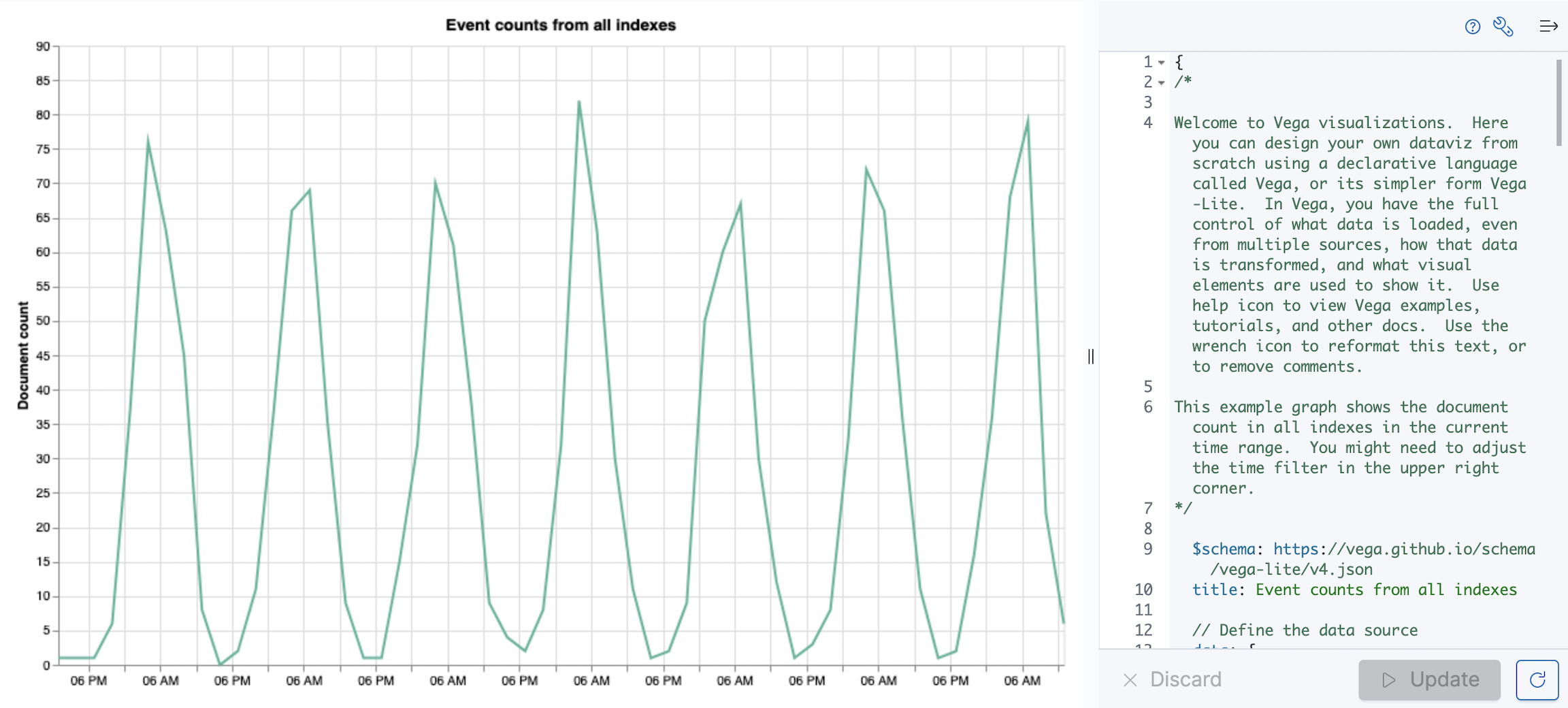
Vega 和 Vega-Lite 都使用 JSON,但 Kibana 通过集成 HJSON 使输入更简单。HJSON 支持以下内容:
- 可选引号
- 双引号或单引号
- 可选逗号
- 使用 // 或 /* 语法的注释
- 多行字符串
教程:创建自定义面板
编辑了解如何将 Vega-Lite 与 Kibana 过滤器和 Elasticsearch 数据连接起来,然后学习如何使用 Vega 创建更多的 Kibana 交互。
在编辑规范时,请小步进行,并经常保存您的工作。小的更改可能会导致意想不到的结果。要保存,请单击工具栏中的 保存。
在开始之前,添加您将在规范中使用的电子商务示例数据,然后创建仪表板。
- 安装电子商务示例数据集.
- 转到 仪表板。
- 在 仪表板 页面上,单击 创建仪表板。
打开并设置 Vega-Lite
编辑打开 Vega-Lite 并更改时间范围。
-
在仪表板上,单击 选择类型,然后选择 自定义可视化。
预先填充的折线图显示文档总数。
- 确保 时间过滤器 是 过去 7 天。
教程:从 Elasticsearch 搜索查询创建堆积面积图
编辑了解如何从 Vega-Lite 查询 Elasticsearch,并将结果显示在堆积面积图中。
- 在 Vega-Lite 规范中,将
index: _all替换为以下内容,然后单击 更新
index: kibana_sample_data_ecommerce
会出现一条具有零结果的平线。
要从 kibana_sample_data_ecommerce 数据视图中添加数据字段,请替换以下内容,然后单击 更新
-
%timefield%: @timestamp替换为%timefield%: order_date -
field: @timestamp替换为field: order_date
添加聚合
编辑要创建堆积面积图,请添加聚合。
要检查您的工作,请在单独的浏览器选项卡上打开并使用 控制台。
- 在新选项卡上打开 Kibana。
- 使用导航菜单或 全局搜索字段 转到 开发工具 页面。
- 在 控制台 编辑器中,输入聚合,然后单击 单击以发送请求
POST kibana_sample_data_ecommerce/_search { "query": { "range": { "order_date": { "gte": "now-7d" } } }, "aggs": { "time_buckets": { "date_histogram": { "field": "order_date", "fixed_interval": "1d", "extended_bounds": { "min": "now-7d" }, "min_doc_count": 0 } } }, "size": 0 }
添加 词项聚合,然后单击 单击以发送请求
POST kibana_sample_data_ecommerce/_search { "query": { "range": { "order_date": { "gte": "now-7d" } } }, "aggs": { "categories": { "terms": { "field": "category.keyword" }, "aggs": { "time_buckets": { "date_histogram": { "field": "order_date", "fixed_interval": "1d", "extended_bounds": { "min": "now-7d" }, "min_doc_count": 0 } } } } }, "size": 0 }
响应格式与第一个聚合查询不同
{ "aggregations" : { "categories" : { "doc_count_error_upper_bound" : 0, "sum_other_doc_count" : 0, "buckets" : [{ "key" : "Men's Clothing", "doc_count" : 1661, "time_buckets" : { "buckets" : [{ "key_as_string" : "2020-06-30T00:00:00.000Z", "key" : 1593475200000, "doc_count" : 19 }, { "key_as_string" : "2020-07-01T00:00:00.000Z", "key" : 1593561600000, "doc_count" : 71 }] } }] } } }
在 Vega-Lite 规范中,输入聚合,然后单击 更新
data: { url: { %context%: true %timefield%: order_date index: kibana_sample_data_ecommerce body: { aggs: { categories: { terms: { field: "category.keyword" } aggs: { time_buckets: { date_histogram: { field: order_date interval: {%autointerval%: true} extended_bounds: { min: {%timefilter%: "min"} max: {%timefilter%: "max"} } min_doc_count: 0 } } } } } size: 0 } } format: {property: "aggregations.categories.buckets" } }
有关查询的信息,请参阅 在 Vega 中编写 Elasticsearch 查询的参考。
调试警告
编辑为了生成数据,Vega-Lite 使用 source_0 和 data_0。source_0 包含来自 Elasticsearch 查询的结果,而 data_0 包含图表上显示的视觉编码结果。要调试警告,请比较 source_0 和 data_0。
- 在工具栏中,单击 检查。
- 从 查看 下拉列表中,选择 Vega 调试。
-
从下拉列表中,选择 source_0。
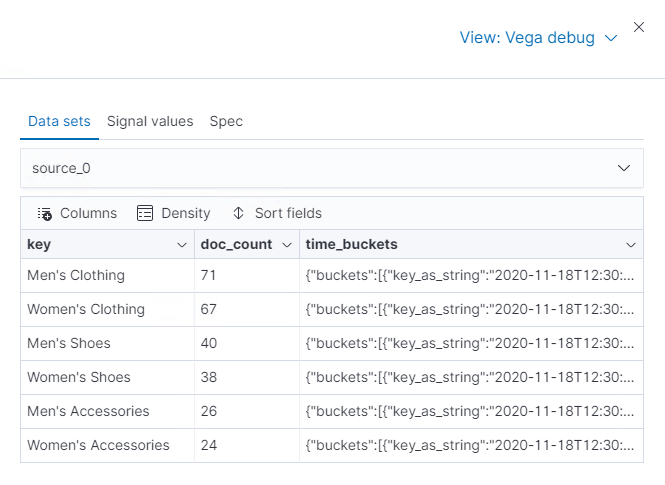
-
要与视觉编码的数据进行比较,请从下拉列表中选择 data_0。
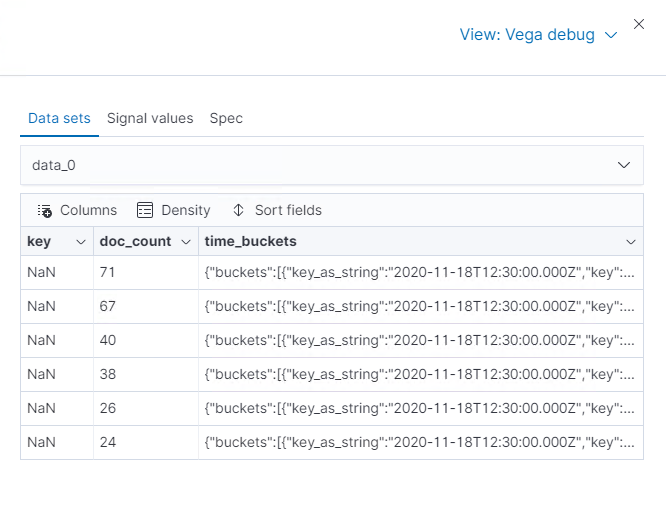
key 无法转换,因为该属性是类别(
男士服装、女士服装等),而不是时间戳。
添加并调试编码块
编辑在 Vega-Lite 规范中,添加 encoding 块
encoding: { x: { field: time_buckets.buckets.key type: temporal axis: { title: null } } y: { field: time_buckets.buckets.doc_count type: quantitative axis: { title: "Document count" } } }
- 单击 检查,然后从 查看 下拉列表中选择 Vega 调试。
-
从下拉列表中,选择 data_0。
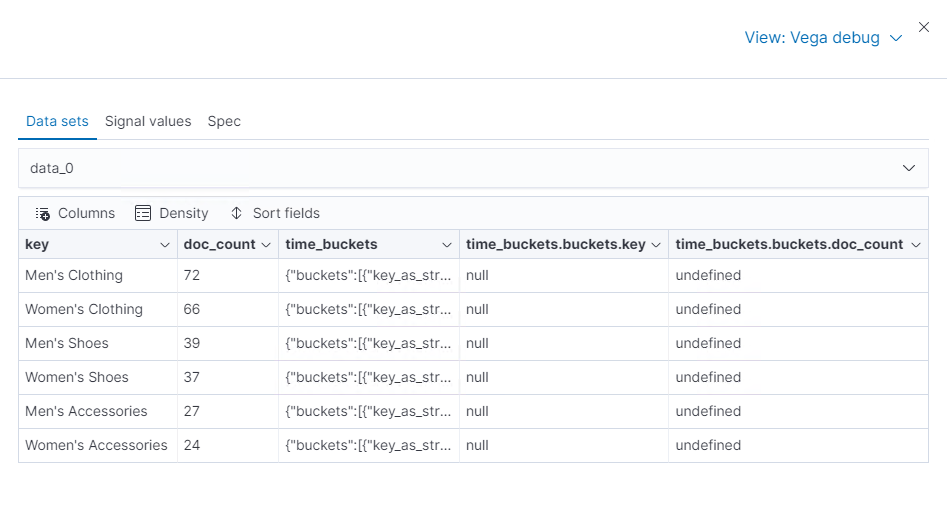
Vega-Lite 无法提取 time_buckets.buckets 内部数组。
提取 time_buckets.buckets 内部数组
编辑在 Kibana 7.9 及更高版本中,使用 Vega-Lite flatten 转换 来提取 time_buckets.buckets 内部数组。
如果您使用的是 Kibana 7.8 及更早版本,则 flatten 转换仅在 Vega 中可用。
在 Vega-Lite 规范中,添加 transform 块,然后单击 更新
transform: [{ flatten: ["time_buckets.buckets"] }]
- 单击 检查,然后从 查看 下拉列表中选择 Vega 调试。
-
从下拉列表中,选择 data_0。
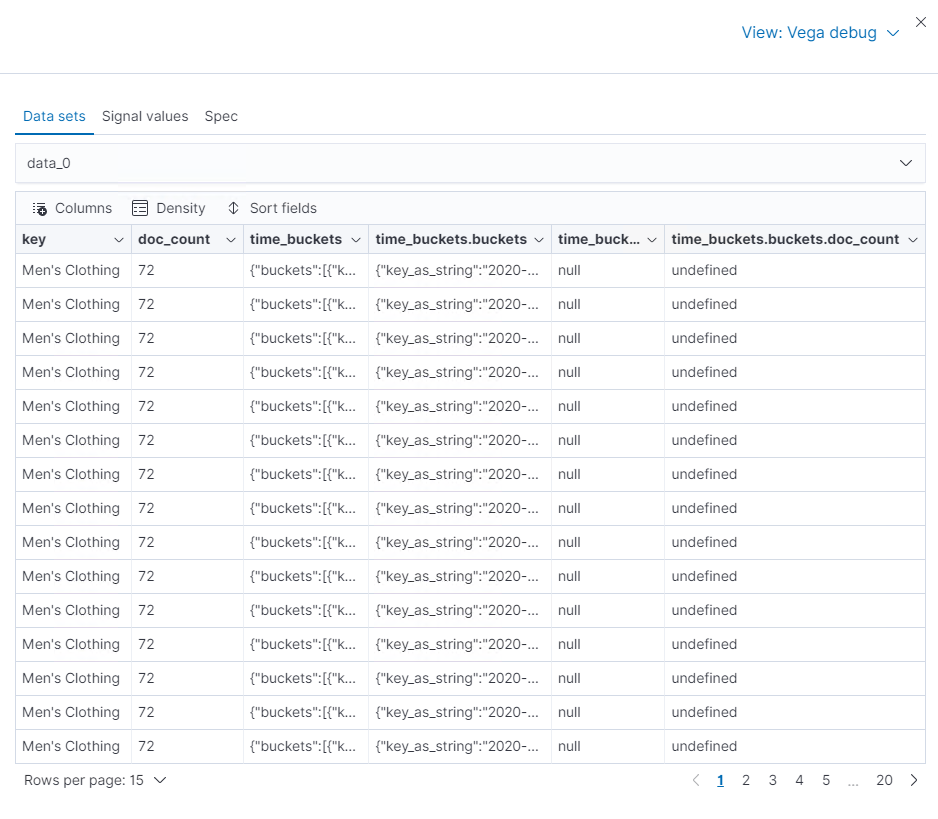
Vega-Lite 显示 未定义 值,因为存在重复的名称。
- 要解决重复名称的问题,请添加
transform和encoding块,然后单击 更新
transform: [{ flatten: ["time_buckets.buckets"], as: ["buckets"] }] mark: area encoding: { x: { field: buckets.key type: temporal axis: { title: null } } y: { field: buckets.doc_count type: quantitative axis: { title: "Document count" } } color: { field: key type: nominal } }
添加悬停状态和工具提示
编辑使用 Vega-Lite 规范,您可以使用 selection 块向堆积面积图添加悬停状态和工具提示。
在 Vega-Lite 规范中,添加 encoding 块,然后单击 更新
encoding: { tooltip: [{ field: buckets.key type: temporal title: "Date" }, { field: key type: nominal title: "Category" }, { field: buckets.doc_count type: quantitative title: "Count" }] }
当您将鼠标悬停在堆积面积图上的面积系列时,会出现一个多行工具提示,但无法指示最近的点。要指示最近的点,请添加第二层。
添加复合标记,然后单击 更新
layer: [{ mark: area }, { mark: point }]
这些点无法堆叠并与堆积面积图对齐。
更改 y encoding
y: { field: buckets.doc_count type: quantitative axis: { title: "Document count" } stack: true }
在 mark: point 内添加 selection 块
layer: [{ mark: area }, { mark: point selection: { pointhover: { type: single on: mouseover clear: mouseout empty: none fields: ["buckets.key", "key"] nearest: true } } encoding: { size: { condition: { selection: pointhover value: 100 } value: 5 } fill: { condition: { selection: pointhover value: white } } } }]
在堆积面积图周围移动光标。这些点能够指示最近的点。
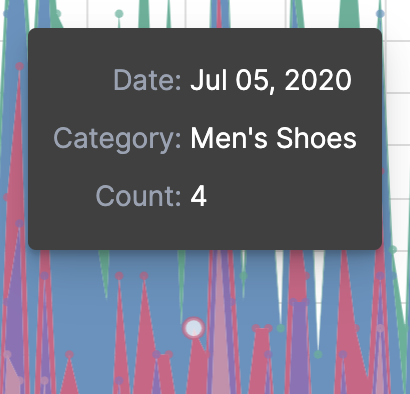
选择由信号控制。要查看信号,请单击工具栏中的 检查。
展开最终 Vega-Lite 规范
{ $schema: https://vega.github.io/schema/vega-lite/v4.json title: Event counts from ecommerce data: { url: { %context%: true %timefield%: order_date index: kibana_sample_data_ecommerce body: { aggs: { categories: { terms: { field: "category.keyword" } aggs: { time_buckets: { date_histogram: { field: order_date interval: {%autointerval%: true} extended_bounds: { min: {%timefilter%: "min"} max: {%timefilter%: "max"} } min_doc_count: 0 } } } } } size: 0 } } format: {property: "aggregations.categories.buckets" } } transform: [{ flatten: ["time_buckets.buckets"] as: ["buckets"] }] encoding: { x: { field: buckets.key type: temporal axis: { title: null } } y: { field: buckets.doc_count type: quantitative axis: { title: "Document count" } stack: true } color: { field: key type: nominal title: "Category" } tooltip: [{ field: buckets.key type: temporal title: "Date" }, { field: key type: nominal title: "Category" }, { field: buckets.doc_count type: quantitative title: "Count" }] } layer: [{ mark: area }, { mark: point selection: { pointhover: { type: single on: mouseover clear: mouseout empty: none fields: ["buckets.key", "key"] nearest: true } } encoding: { size: { condition: { selection: pointhover value: 100 } value: 5 } fill: { condition: { selection: pointhover value: white } } } }] }
教程:从 Vega 更新 Kibana 过滤器
编辑要使用 Elasticsearch 搜索查询构建面积图,请编辑 Vega 规范,然后添加单击和拖动处理程序以更新 Kibana 过滤器。
在 Vega 规范中,输入以下内容,然后单击 更新
{ $schema: "https://vega.github.io/schema/vega/v5.json" data: [{ name: source_0 }] scales: [{ name: x type: time range: width }, { name: y type: linear range: height }] axes: [{ orient: bottom scale: x }, { orient: left scale: y }] marks: [ { type: area from: { data: source_0 } encode: { update: { } } } ] }
使用 data 块添加 Elasticsearch 搜索查询,然后单击 更新
data: [ { name: source_0 url: { %context%: true %timefield%: order_date index: kibana_sample_data_ecommerce body: { aggs: { time_buckets: { date_histogram: { field: order_date fixed_interval: "3h" extended_bounds: { min: {%timefilter%: "min"} max: {%timefilter%: "max"} } min_doc_count: 0 } } } size: 0 } } format: { property: "aggregations.time_buckets.buckets" } } ]
更改 x 轴和 y 轴
编辑显示 x 轴和 y 轴的标签。
在 Vega 规范中,添加 scales 块,然后单击 更新
scales: [{ name: x type: time range: width domain: { data: source_0 field: key } }, { name: y type: linear range: height domain: { data: source_0 field: doc_count } }]
添加 key 和 doc_count 字段作为 X 轴和 Y 轴的值,然后单击 更新
marks: [ { type: area from: { data: source_0 } encode: { update: { x: { scale: x field: key } y: { scale: y value: 0 } y2: { scale: y field: doc_count } } } } ]
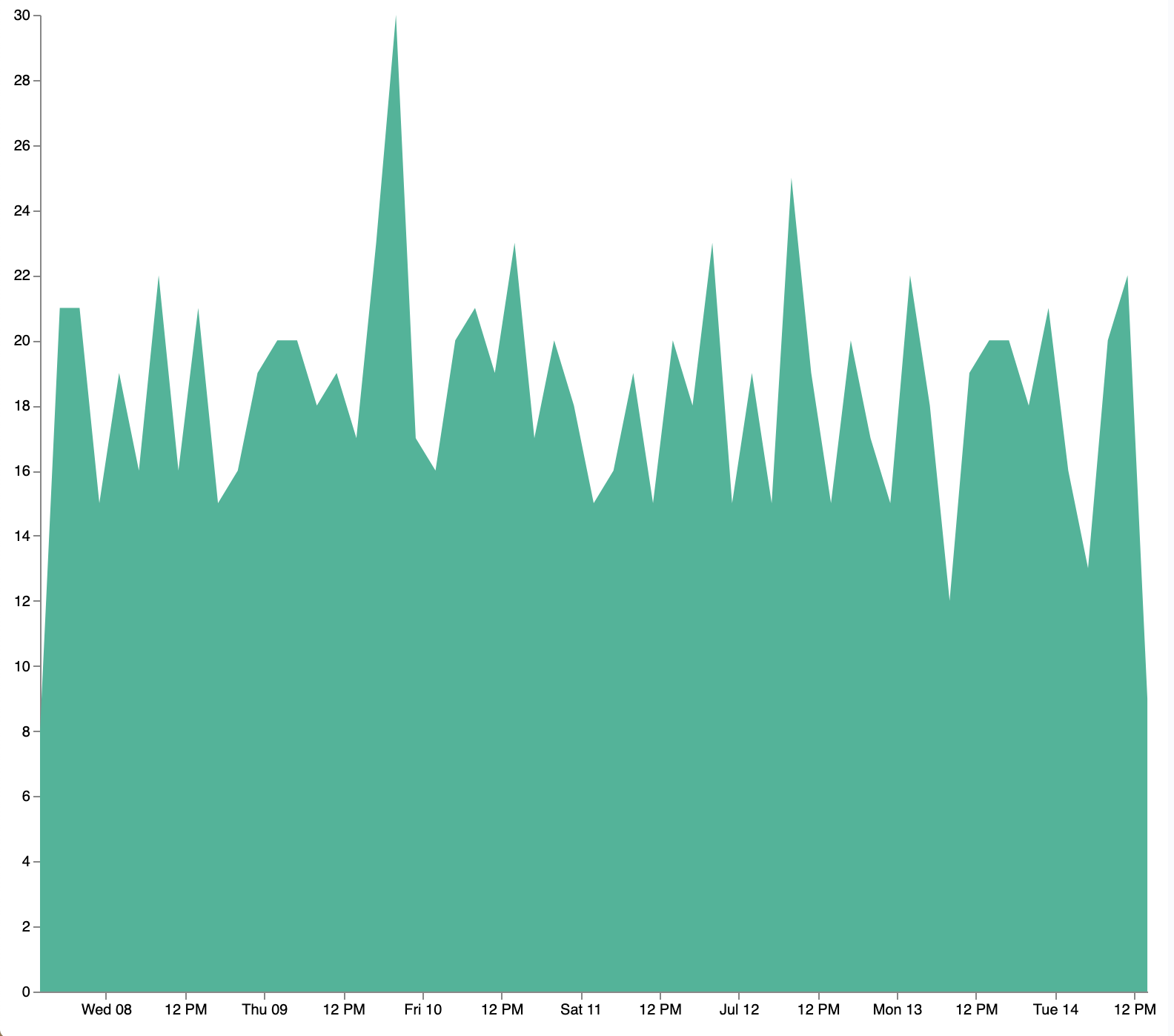
向 marks 部分添加块
编辑在面积图上显示可点击的点以筛选特定日期。
在 Vega 规范中,添加到 marks 代码块,然后单击 更新
{ name: point type: symbol style: ["point"] from: { data: source_0 } encode: { update: { x: { scale: x field: key } y: { scale: y field: doc_count } size: { value: 100 } fill: { value: black } } } }
创建信号
编辑要使点可点击,请创建一个 Vega 信号。您可以在用于更新的表达式中访问点击的 datum。
在 Vega 规范中,添加一个 signals 代码块,以指定光标点击添加具有三个小时间隔的时间过滤器,然后单击 更新
signals: [ { name: point_click on: [{ events: { source: scope type: click markname: point } update: '''kibanaSetTimeFilter(datum.key, datum.key + 3 * 60 * 60 * 1000)''' }] } ]
该事件使用 kibanaSetTimeFilter 自定义函数生成一个过滤器,该过滤器在点击时应用于整个仪表板。
要使面积图具有交互性,请找到 marks 代码块,然后更新 point 并将 cursor: { value: "pointer" } 添加到 encoding
{ name: point type: symbol style: ["point"] from: { data: source_0 } encode: { update: { ... cursor: { value: "pointer" } } } }
添加拖动交互
编辑要允许用户基于时间范围进行过滤,请添加拖动交互,这需要额外的信号和一个矩形覆盖。
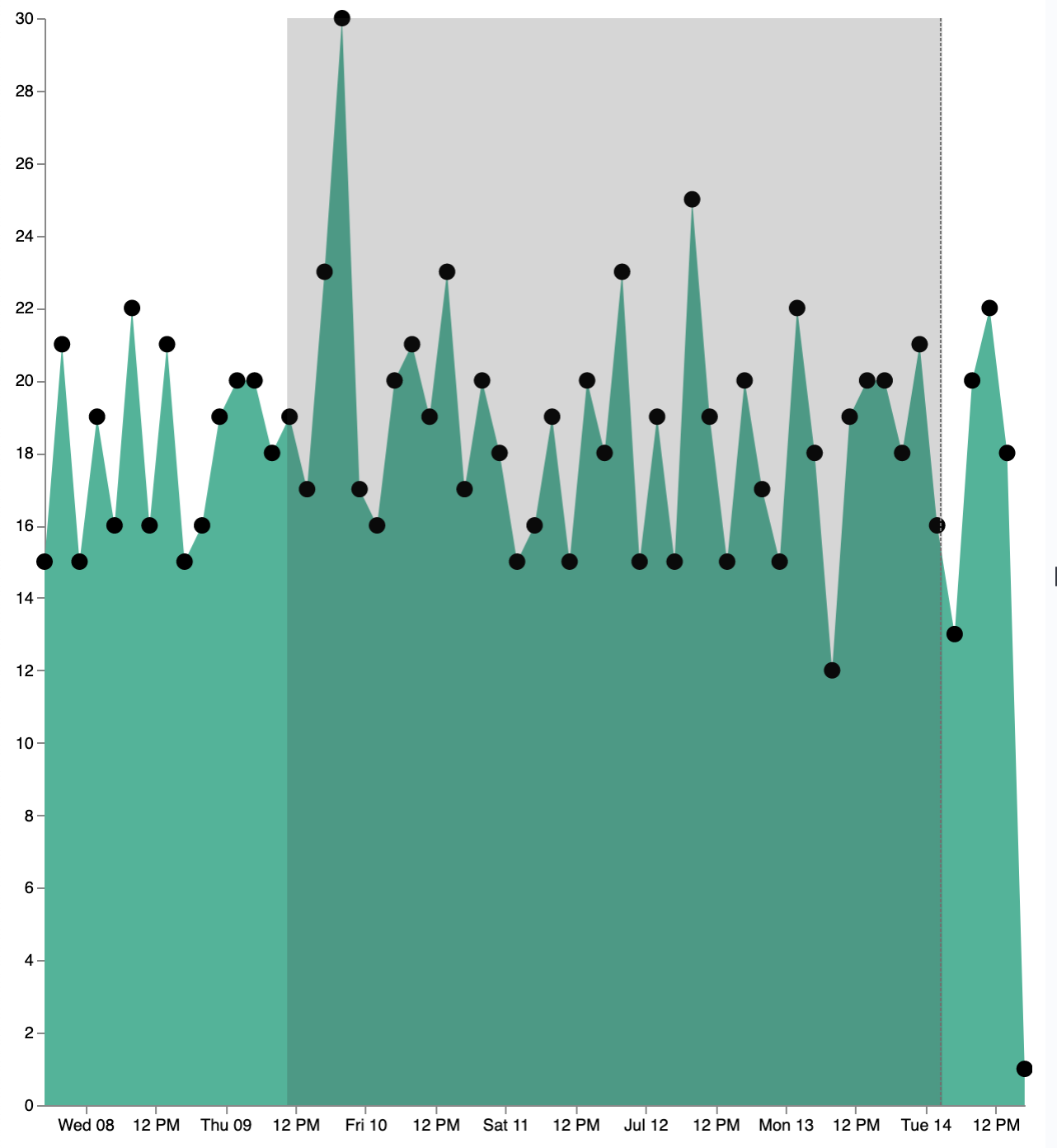
在 Vega 规范中,添加一个 signal 来跟踪光标的 X 位置
{ name: currentX value: -1 on: [{ events: { type: mousemove source: view }, update: "clamp(x(), 0, width)" }, { events: { type: mouseout source: view } update: "-1" }] }
要指示当前光标位置,请添加一个 mark 代码块
{ type: rule interactive: false encode: { update: { y: {value: 0} y2: {signal: "height"} stroke: {value: "gray"} strokeDash: { value: [2, 1] } x: {signal: "max(currentX,0)"} defined: {signal: "currentX > 0"} } } }
要跟踪选定的时间范围,请添加一个信号,该信号会更新直到用户释放光标或按下 Return 键
{ name: selected value: [0, 0] on: [{ events: { type: mousedown source: view } update: "[clamp(x(), 0, width), clamp(x(), 0, width)]" }, { events: { type: mousemove source: window consume: true between: [{ type: mousedown source: view }, { merge: [{ type: mouseup source: window }, { type: keydown source: window filter: "event.key === 'Escape'" }] }] } update: "[selected[0], clamp(x(), 0, width)]" }, { events: { type: keydown source: window filter: "event.key === 'Escape'" } update: "[0, 0]" }] }
有一个信号可以跟踪用户的时间范围。
要直观地指示范围,请添加一个仅在有条件时才出现的标记
{ type: rect name: selectedRect encode: { update: { height: {signal: "height"} fill: {value: "#333"} fillOpacity: {value: 0.2} x: {signal: "selected[0]"} x2: {signal: "selected[1]"} defined: {signal: "selected[0] !== selected[1]"} } } }
添加一个信号,该信号在拖动时释放光标时更新 Kibana 时间过滤器
{ name: applyTimeFilter value: null on: [{ events: { type: mouseup source: view } update: '''selected[0] !== selected[1] ? kibanaSetTimeFilter( invert('x',selected[0]), invert('x',selected[1])) : null''' }] }
展开最终的 Vega 规范
{ $schema: "https://vega.github.io/schema/vega/v5.json" data: [ { name: source_0 url: { %context%: true %timefield%: order_date index: kibana_sample_data_ecommerce body: { aggs: { time_buckets: { date_histogram: { field: order_date fixed_interval: "3h" extended_bounds: { min: {%timefilter%: "min"} max: {%timefilter%: "max"} } min_doc_count: 0 } } } size: 0 } } format: { property: "aggregations.time_buckets.buckets" } } ] scales: [{ name: x type: time range: width domain: { data: source_0 field: key } }, { name: y type: linear range: height domain: { data: source_0 field: doc_count } }] axes: [{ orient: bottom scale: x }, { orient: left scale: y }] marks: [ { type: area from: { data: source_0 } encode: { update: { x: { scale: x field: key } y: { scale: y value: 0 } y2: { scale: y field: doc_count } } } }, { name: point type: symbol style: ["point"] from: { data: source_0 } encode: { update: { x: { scale: x field: key } y: { scale: y field: doc_count } size: { value: 100 } fill: { value: black } cursor: { value: "pointer" } } } }, { type: rule interactive: false encode: { update: { y: {value: 0} y2: {signal: "height"} stroke: {value: "gray"} strokeDash: { value: [2, 1] } x: {signal: "max(currentX,0)"} defined: {signal: "currentX > 0"} } } }, { type: rect name: selectedRect encode: { update: { height: {signal: "height"} fill: {value: "#333"} fillOpacity: {value: 0.2} x: {signal: "selected[0]"} x2: {signal: "selected[1]"} defined: {signal: "selected[0] !== selected[1]"} } } } ] signals: [ { name: point_click on: [{ events: { source: scope type: click markname: point } update: '''kibanaSetTimeFilter(datum.key, datum.key + 3 * 60 * 60 * 1000)''' }] } { name: currentX value: -1 on: [{ events: { type: mousemove source: view }, update: "clamp(x(), 0, width)" }, { events: { type: mouseout source: view } update: "-1" }] } { name: selected value: [0, 0] on: [{ events: { type: mousedown source: view } update: "[clamp(x(), 0, width), clamp(x(), 0, width)]" }, { events: { type: mousemove source: window consume: true between: [{ type: mousedown source: view }, { merge: [{ type: mouseup source: window }, { type: keydown source: window filter: "event.key === 'Escape'" }] }] } update: "[selected[0], clamp(x(), 0, width)]" }, { events: { type: keydown source: window filter: "event.key === 'Escape'" } update: "[0, 0]" }] } { name: applyTimeFilter value: null on: [{ events: { type: mouseup source: view } update: '''selected[0] !== selected[1] ? kibanaSetTimeFilter( invert('x',selected[0]), invert('x',selected[1])) : null''' }] } ] }
Vega 参考
编辑了解有关 Kibana 扩展、其他 Vega 资源和示例的更多信息。
Kibana 扩展的参考
编辑Kibana 扩展了 Vega 和 Vega-Lite,并提供以下支持
- 自动调整大小
- 与 Kibana 匹配的默认主题
- 使用仪表板中的时间范围和过滤器编写 Elasticsearch 查询
- [预览] 此功能为技术预览版,可能会在未来的版本中更改或删除。Elastic 将努力解决任何问题,但技术预览版中的功能不受正式 GA 功能的支持 SLA 的约束。 在 Vega 地图中使用 Elastic Map Service
- 其他工具提示样式
- 启用从任何域加载 URL 的高级设置
- 使用 Kibana 检查器或浏览器控制台进行调试支持
- (仅限 Vega) 可以更新时间范围和仪表板过滤器的表达式函数
自动调整大小
编辑大多数用户都希望他们的 Vega 可视化占据所有可用空间,因此与 Vega 示例不同,width 和 height 在 Kibana 中不是必需的参数,因为在大多数情况下,您的规范将与默认的 Kibana 设置合并
autosize: {
type: fit
contains: padding
}
width: container
height: container
如果出现以下情况,则 不 应用这些默认设置
-
您的规范使用
type=map - 您的规范是 Vega-Lite 并且包含 facet、row、column、repeat 或 concat 运算符。在这些情况下,提供
width和height将会影响子大小。
要手动设置宽度或高度,请设置 autosize: none 并提供精确的像素大小,包括标题、图例和坐标轴的填充。
autosize: none
width: 600
height: 200
padding: {
top: 20
bottom: 20
left: 55
right: 150
}
要了解更多信息,请阅读 Vega 自动调整大小 和 Vega-Lite 自动调整大小。
Vega-Lite 中的自动调整大小具有 一些限制,这些限制可能会影响可视化的宽度和高度,但这些限制在 Vega 中不存在。如果您需要完全控制,请使用 浏览器控制台 VEGA_DEBUG.vega_spec 输出将您的规范转换为 Vega。要禁用这些警告,您可以向您的规范添加额外的选项。
与 Kibana 匹配的默认主题
编辑Kibana 注册一个 ID 为 elastic 的默认 Vega 配色方案,并为每种 mark 类型设置默认颜色。 通过提供不同的 stroke、fill 或 color (Vega-Lite) 值来覆盖它。
在 Vega 中编写 Elasticsearch 查询
编辑Kibana 使用指定为 url 的直接 Elasticsearch 查询扩展了 Vega 数据元素。
Kibana 无法支持动态加载的数据,否则这些数据可以在 Vega 中工作。所有数据都会在传递给 Vega 渲染器之前获取。
要在 Vega 中定义 Elasticsearch 查询,请将 url 设置为对象。Kibana 会解析该对象以查找特殊的标记,这些标记允许您的查询与 Kibana 集成。
标记包括以下内容
-
%context%: true:在顶层设置,并将query部分替换为仪表板中的过滤器 -
%timefield%: <name>:在顶层设置,将查询与仪表板时间过滤器集成 -
{%timefilter%: true}:替换为具有上限和下限的 Elasticsearch 范围查询 -
{%timefilter%: "min" | "max"}:仅替换为上限或下限 -
{%timefilter: true, shift: -1, unit: 'hour'}:生成过去一小时的时间范围查询 -
{%autointerval%: true}:替换为包含 Kibana 自动时间间隔的字符串,例如1h -
{%autointerval%: 10}:替换为将时间大致划分为 10 个范围的字符串,从而使您可以影响自动间隔 -
"%dashboard_context-must_clause%":由包含过滤器的对象替换的字符串 -
"%dashboard_context-filter_clause%":由包含过滤器的对象替换的字符串 -
"%dashboard_context-must_not_clause%":由包含过滤器的对象替换的字符串
Vega 支持 interval 参数,该参数在 Elasticsearch 8.0.0 及更高版本中不受支持。 要使用间隔,请改用 fixed_interval 或 calendar_interval。
例如,以下查询计算特定索引中的文档数
// An object instead of a string for the URL value // is treated as a context-aware Elasticsearch query. url: { // Specify the time filter. %timefield%: @timestamp // Apply dashboard context filters when set %context%: true // Which indexes to search index: kibana_sample_data_logs // The body element may contain "aggs" and "query" keys body: { aggs: { time_buckets: { date_histogram: { // Use date histogram aggregation on @timestamp field field: @timestamp // interval value will depend on the time filter // Use an integer to set approximate bucket count interval: { %autointerval%: true } // Make sure we get an entire range, even if it has no data extended_bounds: { min: { %timefilter%: "min" } max: { %timefilter%: "max" } } // Use this for linear (e.g. line, area) graphs // Without it, empty buckets will not show up min_doc_count: 0 } } } // Speed up the response by only including aggregation results size: 0 } }
完整结果包括以下结构
{ "aggregations": { "time_buckets": { "buckets": [{ "key_as_string": "2015-11-30T22:00:00.000Z", "key": 1448920800000, "doc_count": 28 }, { "key_as_string": "2015-11-30T23:00:00.000Z", "key": 1448924400000, "doc_count": 330 }, ...
对于大多数可视化,您只需要存储桶值的列表。 要仅关注所需的数据,请使用 format: {property: "aggregations.time_buckets.buckets"}。
指定具有单个范围和仪表板上下文的查询。 该查询等效于 "%context%": true, "%timefield%": "@timestamp",但时间范围向后移动了 10 分钟
{ body: { query: { bool: { must: [ // This string will be replaced // with the auto-generated "MUST" clause "%dashboard_context-must_clause%" { range: { // apply timefilter (upper right corner) // to the @timestamp variable @timestamp: { // "%timefilter%" will be replaced with // the current values of the time filter // (from the upper right corner) "%timefilter%": true // Only work with %timefilter% // Shift current timefilter by 10 units back shift: 10 // week, day (default), hour, minute, second unit: minute } } } ] must_not: [ // This string will be replaced with // the auto-generated "MUST-NOT" clause "%dashboard_context-must_not_clause%" ] filter: [ // This string will be replaced // with the auto-generated "FILTER" clause "%dashboard_context-filter_clause%" ] } } } }
当使用 "%context%": true 或为 "%timefield%" 定义值时,正文不能包含查询。 要在 VEGA 规范中自定义查询(例如,添加额外的过滤器或移动时间过滤器),请定义您的查询并使用占位符,如上面的示例所示。 一旦解析,占位符将被仪表板或可视化的实际上下文替换。
"%timefilter%" 也可用于指定单个最小值或最大值。 date_histogram 的 extended_bounds 可以设置为两个值 - 最小值和最大值。 您可以使用 "min": {"%timefilter%": "min"} 而不是硬编码一个值,它将被当前时间范围的开始替换。 还支持 shift 和 unit 值。 "interval" 也可以动态设置,具体取决于当前选择的范围:"interval": {"%autointerval%": 10} 将尝试获取大约 10-15 个数据点(存储桶)。
访问 Elastic Map Service 文件
编辑[预览] 此功能为技术预览版,可能会在未来的版本中更改或删除。Elastic 将努力解决任何问题,但技术预览版中的功能不受正式 GA 功能的支持 SLA 的约束。 通过相同的机制访问 Elastic Map Service 文件
url: { // "type" defaults to "elasticsearch" otherwise %type%: emsfile // Name of the file, exactly as in https://maps.elastic.co name: World Countries } // The result is either a topojson file or a geojson file. // Refer to the Default format for the file at https://maps.elastic.co // Get its features to use this data source with the "shape" marks // https://vega.github.io/vega/docs/marks/shape/ // For a topojson file use format: {type: "topojson", feature: "data"} // For a geojson file use format: {property: "features"}
带有地图的 Vega
编辑 [预览] 此功能为技术预览版,可能会在未来的版本中更改或删除。Elastic 将努力解决任何问题,但技术预览版中的功能不受正式 GA 功能的支持 SLA 的约束。 要启用 地图,图表必须在主机配置中指定 type=map
{ "config": { "kibana": { "type": "map", // Initial map position "latitude": 40.7, // default 0 "longitude": -74, // default 0 "zoom": 7, // default 2 // Defaults to 'true', disables the base map layer. "mapStyle": false, // When 'mapStyle' is 'undefined' or 'true', sets the EMS-layer for the map. // May either be: "road_map", "road_map_desaturated", "dark_map". // If 'emsTileServiceId' is 'undefined', it falls back to the auto-switch-dark-light behavior. "emsTileServiceId": "road_map", // default 0 "minZoom": 5, // defaults to the maximum for the given style, // or 25 when base is disabled "maxZoom": 13, // Defaults to 'true', shows +/- buttons to zoom in/out "zoomControl": false, // Defaults to 'false', disables mouse wheel zoom. If set to // 'true', map may zoom unexpectedly while scrolling dashboard "scrollWheelZoom": false, // When false, repaints on each move frame. // Makes the graph slower when moving the map "delayRepaint": true, // default true } }, /* the rest of Vega JSON */ }
可视化会自动注入一个 "projection",您可以使用它来计算所有地理感知标记的位置。此外,您可以使用 latitude、longitude 和 zoom 信号。这些信号可以在图表中,也可以更新以修改地图的位置。
[预览] 此功能为技术预览版,可能会在未来的版本中更改或删除。Elastic 将努力解决任何问题,但技术预览版中的功能不受正式 GA 功能的支持 SLA 的约束。 您可以使用 Vega 数据元素通过将 url.data 设置为 emsFile 来访问 Vega 地图中 Elastic Maps Service (EMS) 行政边界的矢量形状
"data": [ { "name": "countries", "url": { // "type" defaults to "elasticsearch" otherwise %type%: emsfile // Name of the file, exactly as in the Region map visualization name: World Countries }, // The result is a topojson file, get its features to use // this data source with the "shape" marks // https://vega.github.io/vega/docs/marks/shape/ "format": {"type": "topojson", "feature": "data"}, } ], "marks": [ { "type": "shape", "from": {"data": "countries"}, "transform": [{"type": "geoshape", "projection": "projection"}] } ]
其他工具提示样式
编辑Kibana 安装了 Vega 工具提示插件,因此工具提示可以按照此处记录的方式定义。除此之外,Kibana 还支持用于更改工具提示位置和填充的配置选项
{ config: { kibana: { tooltips: { position: 'top', padding: 15, textTruncate: true, } } } }
启用从任何域加载 URL
编辑Vega 可以从任何 URL 加载数据。要启用此功能,请在 kibana.yml 中设置 vis_type_vega.enableExternalUrls: true,然后重启 Kibana。
外部 URL 加载的文件必须允许 CORS。远程 URL 必须包含 Access-Control-Allow-Origin,它允许来自 Kibana URL 的请求。
您可以使用占位符 %timefilter_min% 和 %timefilter_max%,将当前时间范围作为毫秒时间戳添加到外部 URL 中,例如 http://example.com?min=%timefilter_min%。
Vega 检查器
编辑使用上下文菜单中的 检查 工具来深入了解不同的元素。
检查 Elasticsearch 请求
编辑Vega 使用 Elasticsearch 搜索 API 从 Elasticsearch 获取文档和聚合结果。要对这些请求进行故障排除,请单击 检查,它会显示最近的请求。如果您的规范包含多个请求,您可以使用 视图 下拉菜单在视图之间切换。
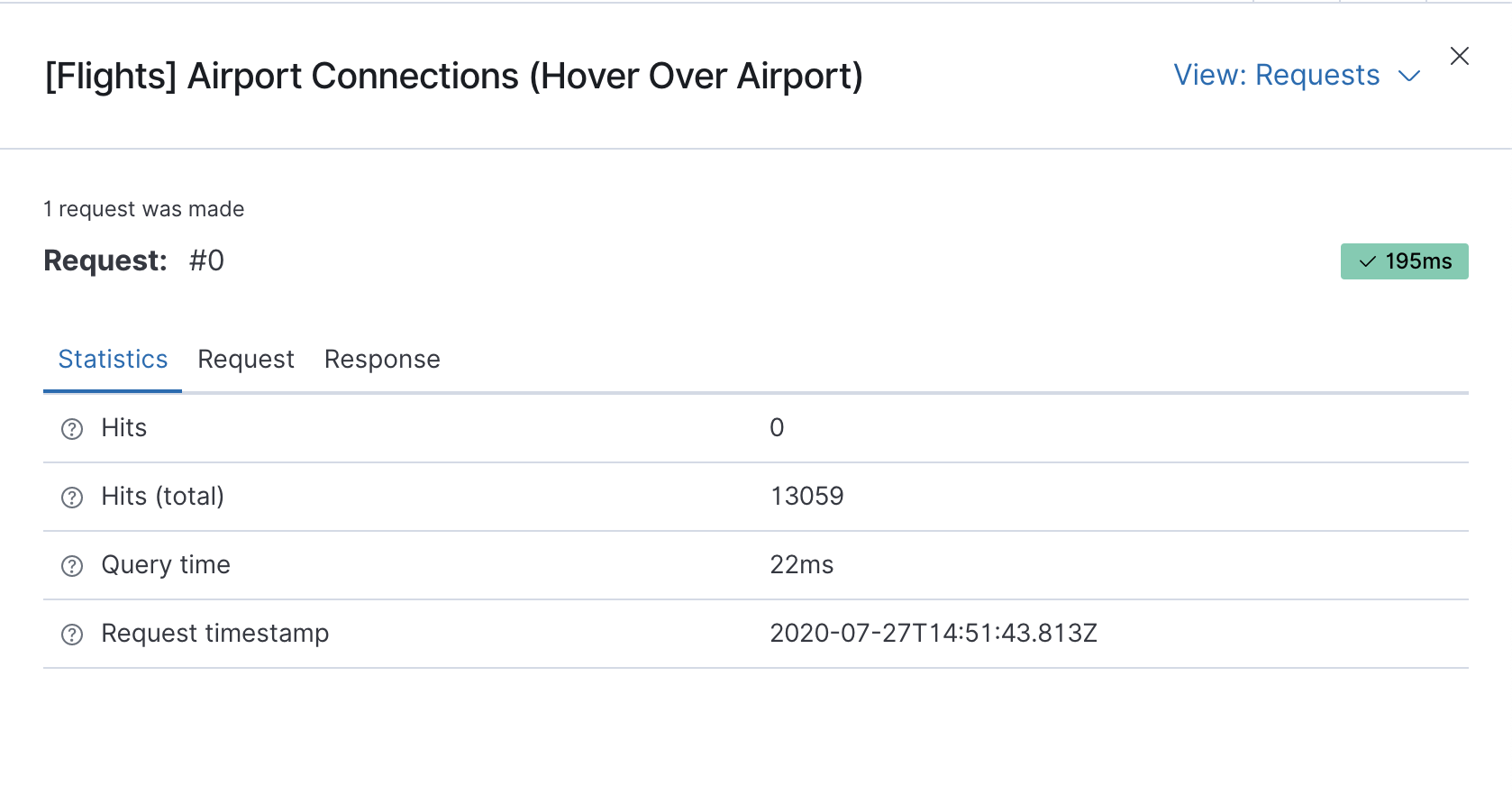
Vega 调试
编辑通过 Vega 调试 视图,您可以检查 数据集 和 信号值 的运行时数据。
运行时数据是从 运行时作用域 读取的。
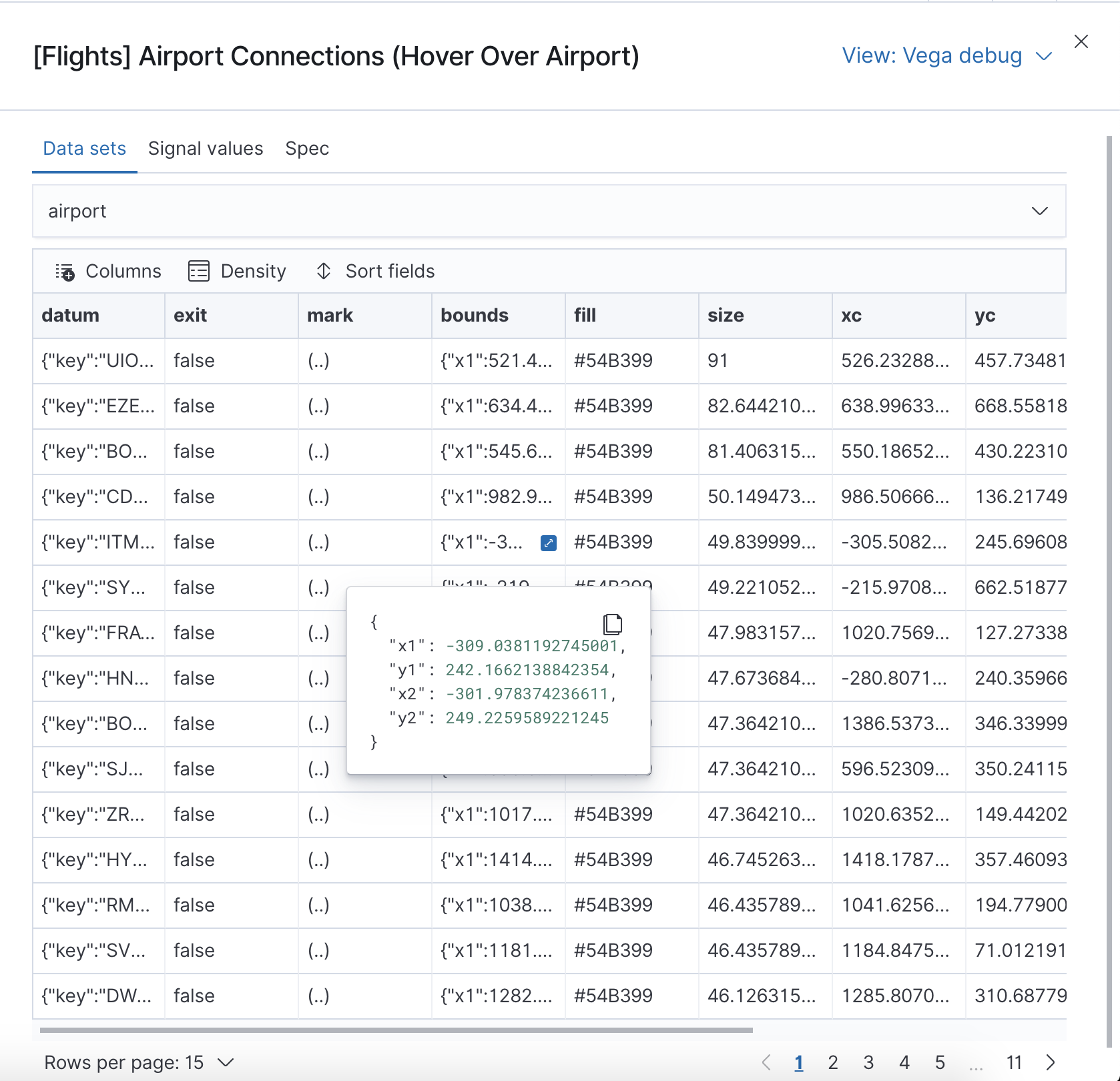
要调试更复杂的规范,请访问 view 变量。有关更多信息,请参阅 Vega 浏览器调试过程。
请求帮助解决 Vega 规范
编辑由于 Elasticsearch 中数据的动态特性,除非您可以共享数据集,否则很难帮助您解决 Vega 规范的问题。为此,请单击 检查,选择 Vega 调试 视图,然后选择 规范。
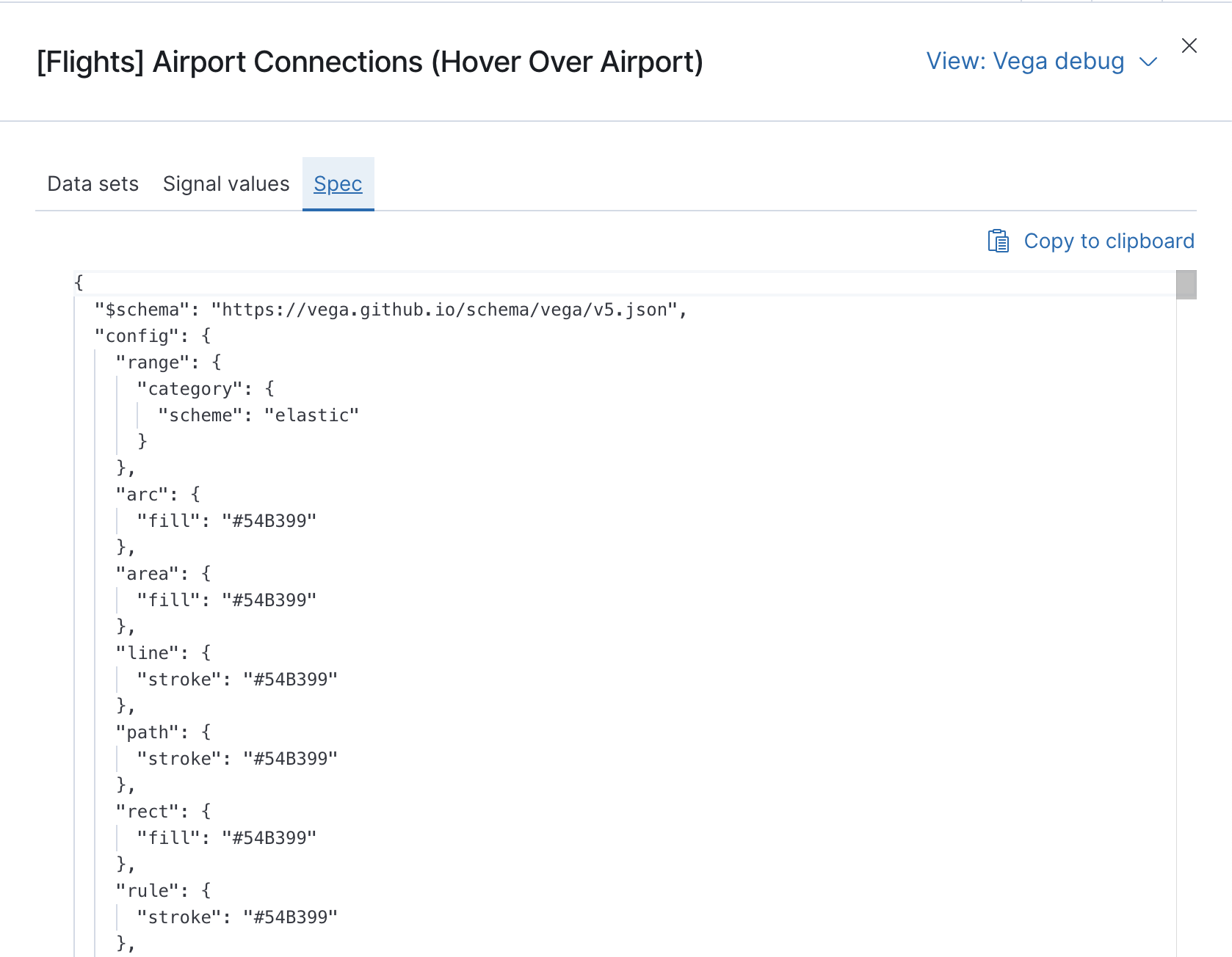
要复制响应,请单击 复制到剪贴板。将复制的数据粘贴到 gist.github.com,可以使用 .json 扩展名。使用 [raw] 按钮,并在请求帮助时共享该链接。
浏览器调试控制台
编辑 [预览] 此功能处于技术预览阶段,可能会在未来的版本中更改或删除。Elastic 将努力解决任何问题,但技术预览中的功能不受官方 GA 功能的支持 SLA 的约束。 使用浏览器调试工具(例如,在 Chrome 中使用 F12 或 Ctrl+Shift+J)来检查 VEGA_DEBUG 变量
-
view— 访问 Vega View 对象。有关如何在运行时检查数据和信号,请参阅 Vega 调试指南。对于 Vega-Lite,VEGA_DEBUG.view.data('source_0')获取预转换数据,而VEGA_DEBUG.view.data('data_0')获取编码数据。对于 Vega,它使用 Vega 规范中定义的数据名称。 -
vega_spec— Kibana 进行一些修改后的 Vega JSON 图形规范。对于 Vega-Lite,这是 Vega-Lite 编译器的输出。 -
vegalite_spec— 如果这是一个 Vega-Lite 图形,则这是 Vega-Lite 编译之前的图形的 JSON 规范。
(仅限 Vega)可以更新时间范围和仪表板过滤器的表达式函数
编辑Kibana 已使用这些函数扩展了 Vega 表达式语言。这些函数将触发获取新数据,默认情况下,这将重置 Vega 信号。要保留设置的信号值,请在 Vega 配置中设置 restoreSignalValuesOnRefresh: true。
/** * @param {object} query Elastic Query DSL snippet, as used in the query DSL editor * @param {string} [index] as defined in Kibana, or default if missing * @param {string} Custom label of the filter shown in the filter bar */ kibanaAddFilter(query, index, alias) /** * @param {object} query Elastic Query DSL snippet, as used in the query DSL editor * @param {string} [index] as defined in Kibana, or default if missing */ kibanaRemoveFilter(query, index) kibanaRemoveAllFilters() /** * Update dashboard time filter to the new values * @param {number|string|Date} start * @param {number|string|Date} end */ kibanaSetTimeFilter(start, end)
其他配置选项
编辑{ config: { kibana: { // Placement of the Vega-defined signal bindings. // Can be `left`, `right`, `top`, or `bottom` (default). controlsLocation: top // Can be `vertical` or `horizontal` (default). controlsDirection: vertical // If true, hides most of Vega and Vega-Lite warnings hideWarnings: true // Vega renderer to use: `svg` or `canvas` (default) renderer: canvas // Defaults to 'false', restores Vega signal values on refresh restoreSignalValuesOnRefresh: false } } }
资源和示例
编辑要了解有关 Vega 和 Vega-Lite 的更多信息,请参阅资源和示例。
Vega 编辑器
编辑Vega 编辑器 包含 Vega 和 Vega-Lite 的示例,但不支持任何 Kibana 特定的功能,如 Elasticsearch 请求和交互式底图。
Vega-Lite 资源
编辑Vega 资源
编辑当您在 Kibana 中使用示例时,可能需要修改 "data" 部分以使用绝对 URL。例如,将 "url": "data/world-110m.json" 替换为 "url": "https://vega.github.io/editor/data/world-110m.json"。
On this page
- 教程:创建自定义面板
- 打开并设置 Vega-Lite
- 教程:从 Elasticsearch 搜索查询创建堆积面积图
- 添加聚合
- 调试警告
- 添加并调试编码块
- 提取
time_buckets.buckets内部数组 - 添加悬停状态和工具提示
- 教程:从 Vega 更新 Kibana 过滤器
- 更改 x 轴和 y 轴
- 向
marks部分添加块 - 创建信号
- 添加拖动交互
- Vega 参考
- Kibana 扩展的参考
- 访问 Elastic Map Service 文件
- 带有地图的 Vega
- Vega 调试
- 浏览器调试控制台
- (仅限 Vega)可以更新时间范围和仪表板过滤器的表达式函数
- 其他配置选项
- 资源和示例
- Vega 编辑器
- Vega-Lite 资源
- Vega 资源